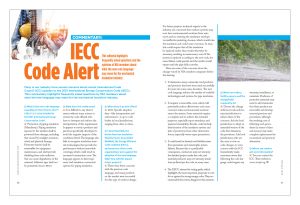Commentary: IECC Code Alert
This editorial highlights frequently asked questions and the opinions of NIA members about what the new code language may mean for the mechanical insulation industry.
Many in our industry have voiced concerns about recent International Code Council (ICC) updates to the 2021 International Energy Conservation Code (IECC). This commentary highlights frequently asked questions by NIA members about what the new language may mean for the mechanical insulation industry.
Q: What is the new code language regarding CE150-19 Part I, IECC®: C403.11.3.1 to be included in the 2021 International Energy Conservation Code?
A: Protection of piping insulation (Mandatory). Piping insulation exposed to the weather shall be protected from damage, including that caused by sunlight, moisture, wind, and physical damage. Protective barrier shall be removable for equipment maintenance, and shall provide shielding from solar radiation that can cause degradation of the material. Adhesive tape shall not be permitted. (Source: IECC)
Q: What does this really mean?
A: It is difficult to say what it means without some actions or reviews by code officials who have to interpret and enforce the interpretation of this requirement. It appears to restrict products and practices specifically developed to avoid the negative impacts of the conditions listed. The language also fails to recognize insulation material technologies that provide the performance without removable coverings, which could result in increased construction costs. The language appears to limit engineers’ and insulation contractors’ options for piping insulation.
Q: When does it go into effect?
A: 2021. Specific adoption date—like interpretation and enforcement—is up to code bodies in local jurisdictions, ranging from cities to states.
Q: I heard that NIA, the North American Insulation Manufacturers Association (NAIMA), the Energy Efficient Code Coalition (EECC), and numerous other trade organizations were against the adoption of the new language. Why? How will this impact future projects?
A: There were fewer concerns with the previous code language, and many products on the market were successful for this type of outdoor design. For future projects, technical experts in the industry are concerned that outdoor systems may now have environmental moisture from rain, snow, and ice entering the insulation envelope via ineffective jacketing closures, which would ruin the insulation and could cause corrosion. In turn, this could require that all the insulation be replaced earlier than would otherwise be necessary, resulting in unnecessary costs. If the system is replaced according to the new code, the same failure could prevail, and the results would repeat until the pipe fully corrodes. Here are some of the concerns about the change voiced by NIA member companies before the hearing:
- It eliminates many commonly used products and practices that have been used successfully for years (in some cases, decades). The new code language reduces the market of available technologies and systems for pipe insulation.
- It requires a removable cover, which will potentially reduce effectiveness and cause corrosion when environmental moisture enters the system. Some materials require a complete seal to achieve the intended purposes, especially vapor retardancy and repeated cleanability. Results could include deterioration of the insulation system and lack of protection from other destructive forces, especially water vapor permeation.
- It could result in lawsuits and liability issues from premature and catastrophic system failures. Because this is a predictable consequence, contractors may not warranty the finished project under the code, and material producers may not warranty insulations jacketed per the code, in many cases.
- The EECC released its voting guide, which highlights the most important proposals to vote for or against for strong energy codes. They recommended that voters disapprove this measure.
Q: What can readers, facility owners, and the design/build community do?
A: Discuss the change with local code enforcement jurisdictions to inform them of the concerns. Ask the local jurisdiction to adopt an amended version of the code that eliminates the provisions. Ask local jurisdictions, who are the ones to vote on code changes, to voice concern with the ICC. Immediately make customers aware that following the code language could negate any warranty, installation, or materials. Producers of protective materials may need to add statements that their products are removable and develop removal practices and procedures, although the resulting cost of following such procedures (in terms of time and money) may make complete replacement the economical and practical alternative.
Q: Where can readers get more information?
A: You can contact the ICC. Their website is www.iccsafe.org.
Copyright statement
This article was published in the January 2020 issue of Insulation Outlook magazine. Copyright © 2020 National Insulation Association. All rights reserved. The contents of this website and Insulation Outlook magazine may not be reproduced in any means, in whole or in part, without the prior written permission of the publisher and NIA. Any unauthorized duplication is strictly prohibited and would violate NIA’s copyright and may violate other copyright agreements that NIA has with authors and partners. Contact publisher@insulation.org to reprint or reproduce this content.
Disclaimer: Unless specifically noted at the beginning of the article, the content, calculations, and opinions expressed by the author(s) of any article in Insulation Outlook are those of the author(s) and do not necessarily reflect the views of NIA. The appearance of an article, advertisement, and/or product or service information in Insulation Outlook does not constitute an endorsement of such products or services by NIA. Every effort will be made to avoid the use or mention of specific product brand names in featured magazine articles.

